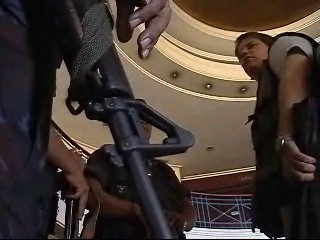Pacific News Center
Burma's narcotics labs produce a blended pill form of crystal methamphetamine – Yaba, Ecstasy, and other street terms - and continues to be a major source ...
. -##M:[more]##Burma Crisis: Drug flood fears across region
PNC Special Report: Myanmar Crisis
The U.S. State Department released its International Narcotics report for 2008, which warns that the political problems in Burma are leaving drug production centers unchecked, and corruption problems in government mean that it has become Asia’s central distribution area for meth pills and production point for many criminal trafficking groups. Hawaii, Guam and the U.S. West Coast could feel the impact“Burma’s military regime has not made the necessary efforts to curb production and has also been very lackluster in the areas of demand reduction,” Christy McCampbell , Deputy Assistant Secretary for International Narcotics and Law Enforcement Affairs told reporters at a briefing.
Worse, even prior to the crisis, there seemed to be little effort to stem the trade and the U.S. Drug Enforcement Agency (DEA) believes this may indicate large scale participation of security forces in the protection of the production center, “We think these are important, interdiction that’s very important and combating corruption. ” McCampbell added.CRISIS DEEPENING TENSION RISING
On the streets of what the military junta calls, Yangoon, Myanmar, there is fear. Last Thursday night, reports of arrests and deaths surfaced, as a crackdown began against over 100,000 people who had been filling the streets daily in protest. Led by Buddhist monks, the brave marched in over violent dispersals from an earlier smaller march. There is mass anger over fuel price increases that have hit the poor, and most Burmese, hard.
The marches in Yangoon were seeking a formal apology from the country’s military rulers, as earlier protests had been met by military force. It all started on August 15th when the Myanmar government raised the price of fuel by 500%, taking away subsidies that had kept life liveable for the poorest of the people once called Burmese.
“This sparked a series of peaceful demonstrations all over the country, beginning with demonstrations in Rangoon, now called Yangon, the former capital of the country. They have since spread to Pakokku and Mandalay in Northern Burma.” Free Foreign Policy center reported Thursday, “In Pakokku, Buddhist monks reportedly took army officers hostage for a few hours, then in Mandalay, where traditionally monks have been highly politicized and aware, the army has units surrounding the city in readiness for an inevitable clampdown.”
The US government and European Union have warned Myanmar’s military rulers to respect human rights, allow the will of the people and free elected leaders it has kept under house arrest for nearly two decades. Burma’s government had earlier been hit hard by the United States a week ago when it was named a major narcotics producer.
‘MAJOR’ NARCOTICS PRODUCING COUNTRY
Burma’s narcotics labs produce a blended pill form of crystal methamphetamine – Yaba, Ecstasy, and other street terms - and continues to be a major source of problems for the Asia Pacific region, so reports the U.S. DEA.
In the recent briefing held in Washington D.C., Burma’s drugs are trans-shipped though other Southeast Asian countries like Thailand, the Philippines, and Cambodia, and onto Palau, the Federated States of Micronesia, and Commonwealth of the Northern Marianas Islands (CNMI). The State Department says it continues to be a threat to the people of Guam, Hawaii and the West Coast of the United States.
“Burma is the largest source of methamphetamine pills in Asia and pill production continues to grow.” McCampbell pointed to a marked shift in Burma from opium to ‘meth pills’ and ‘ice’ production, “The country’s declining poppy cultivation has been matched by a sharp increase in methamphetamine production.”
Burma was singled out in the report along with Venezuela, but the Burmese problem is more directly effecting Americans living in the Pacific Rim, with drug trafficking organizations believed using the American Pacific islands, Guam, the CNMI, and Hawaii as larger dollar earning markets for the products they make. Pill form methamphetamine, is often considered by drug enforcement agencies as the most deadly, often causing severe mental side effects and instant addiction. Burma’s continued failure to act on its growing role as a narcotics trade center will lead to the imposition of trade and economic penalties under U.S. law.
DEA Issues warning to Law Enforcement to expect more ‘Burma pills’
The DEA reports, “Methamphetamine tablets are produced primarily in Burma and usually contain a combination of powder methamphetamine and caffeine.” Description and types of pills seized over the years vary, “Methamphetamine tablets found in the United States typically are green or orange-red in color, imprinted with a variety of symbols, most commonly WY or R.
“The pills are approximately the size of a pencil eraser.” The use often varies. “Methamphetamine tablets typically are ingested orally and often are flavored and scented like candy grape, orange, or vanilla.” Tablets also are smoked by placing the tablet on a piece of aluminum foil and passing a heat source underneath the foil until the tablet melts and vapors - which are inhaled -are released.
Regional narcotics experts fear that with the Burmese military engaged in a crackdown on dissidents, there may be a rise in the smuggling operations of pill-based and more traditional opium deliveries along the ‘Golden Triangle’. - PNC International
Sunday, September 30, 2007
A story I rote for a Guam based website that i think is what may from the sources I interviewed a likely outcome of the crisis in Burma.
Subscribe to:
Post Comments (Atom)

No comments:
Post a Comment